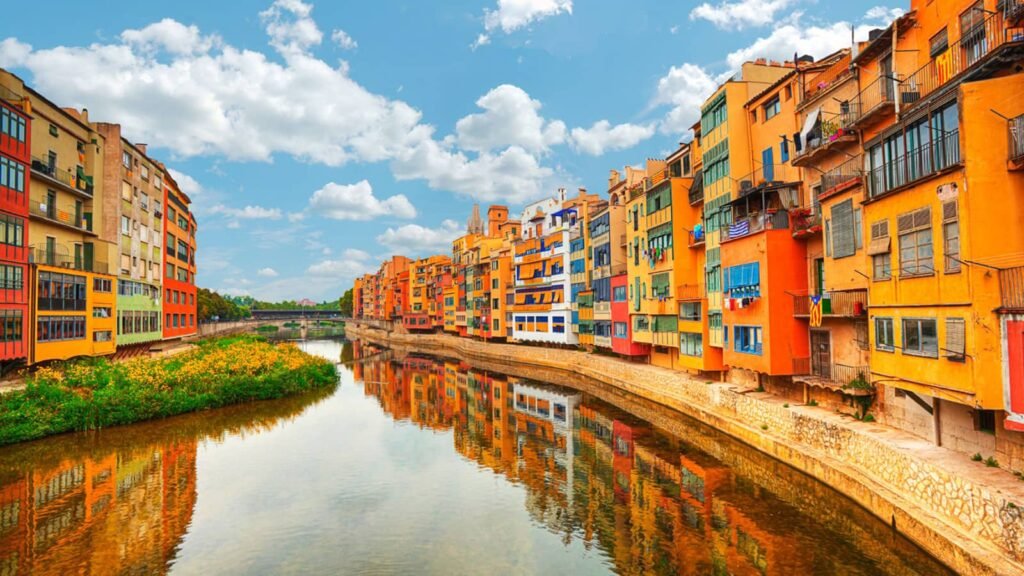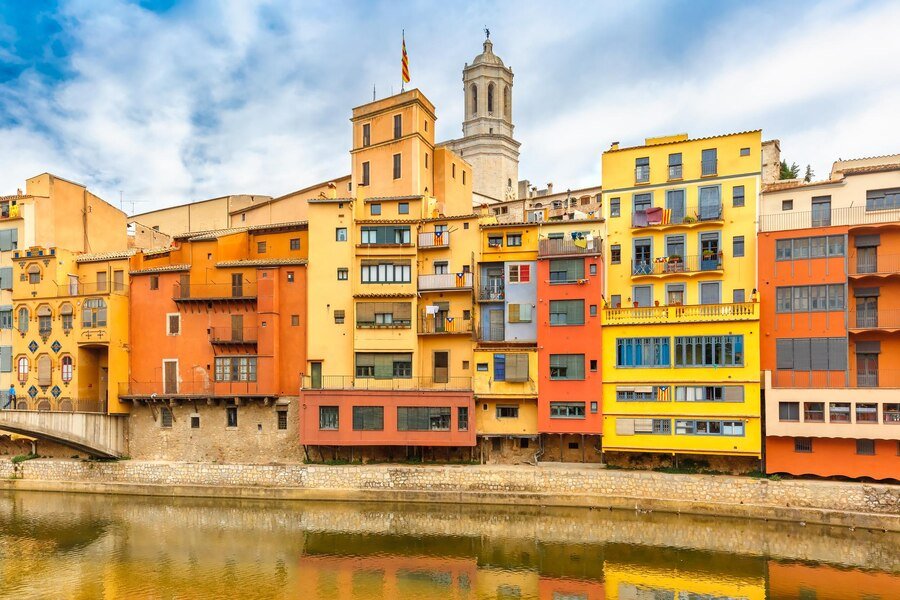The wonderful Spanish city has many places to visit and monuments to see. The historic city is also associated with Jewish culture and traces of the Arab. Tthe provinces of Girona are associated with the life and death of Salvador Dalí. Check out what Girona has to offer !

Girona is a city located in northeastern Spain, in the Catalonia region. Girona is the capital of the province of the same name and the comarque of Gironès. Catalonia, on the other hand, occupies an area located on the Mediterranean Sea, on the border with France and Andorra.

Attractions
- Girona Cathedral

Girona Cathedral is located in Cathedral Square and is consecrated in honor of the Blessed Virgin Mary. Later, the temple underwent many changes, thanks to which you can see combinations of various architectural styles in its architecture The main monument of the cathedral is a huge woven Catalan carpet “The Creation of the World”.
2. Arab Baths

It is also worth seeing the Arab Baths, which were built at the end of the 12th century on the orders of King Alfonso II the Chaste. The baths are built in the Romanesque style and with some decorative elements typical of Arab baths. The bathhouse building was renovated many times. Today it houses a museum that hosts exhibitions of contemporary art.
3. Casas del Onyar

Houses on the banks of the Onyar River are extremely atmospheric, colorful houses in Girona. The buildings were built in the 17th century on the basis of ruined city walls, and were later rebuilt many times. You can see the houses by walking along the bridge over the river, this is the perfect place to admire the striking colorful houses and take photos of the panorama.
4. Pont de les Peixateries Velles

Iron Bridge, Pont de les Peixateries Velles (Pont de Eiffel) It was built by the Eiffel company in 1876 (later renovated) and connects the heart of the old city with the new city. The bridge crosses the Onyar River from Calle de Santa Clara and the Mercadal area towards Rambla de la Libertad and Calle de la Argenteria. The characteristic red color gives the structure character, so many tourists and residents want to see it.
5. Girona City Walls

The city has a very long history. Since Roman times, battles for them have taken place in almost every century, as evidenced by the huge defensive walls and diverse architectural styles. Iberians, Romans, Greeks, also Arabs, French and Jews ruled here. The famous 9th-century city walls with paths, towers and viewpoints from which you can admire the surrounding area.

6. Sant Pere de Galligants

The monastery of Sant Pere de Galligants from the 12th century is one of the most important Romanesque monuments in Girona, with a chancel and a bell tower. And since 1857, it has been the seat of the Archaeological Museum of Catalonia.
7. Basilica of Sant Feliu

The Church of Saint-Félix or Saint Feliu in Girona is a collegiate basilica dating back to the beginnings of Christianity. The temple is built on an elevated hill on which most of the Roman city stretched. It was built in honor of the martyr Saint Felix. Besides the Gothic tower, the building is known for its extraordinary eight Roman and early Christian sarcophagi of the 3rd and 4th centuries, built on the walls of the presbytery.
8. Museu d’Història dels Jueus

Museum d’Historia dels Jueus – The museum presents the history of the Jewish population of Girona in the Middle Ages. Here you can see 11 galleries that form a route leading visitors through topics such as: the arrival of the Jewish people in Catalonia, the physical evolution of the call (medieval Jewish quarter), rituals and traditions, the synagogue, the Jewish cemetery, Nachmanides, the cultural and scientific activities of Catalan Jews, difficult relations Jewish and Christian communities towards the Inquisition and material heritage.
9. Museu del Cinema-Col·lecció Tomàs Mallol

Cinema Museum – Tomàs Mallol Collection is a museum dedicated to the world of film and moving images. The exhibition area begins on the lower floor, where the prologue is an audiovisual show. The first part, on the third floor, is devoted to the puppets of the Chinese shadow theater, an art with ancestral roots. Then, in the interior of a room devoid of light, the camera obscura allows you to see the reflection of external images of the world and understand why this phenomenon is the basis of the technique of photography and cinema.
The next chapter is devoted to mirrors, which allowed us to capture ephemeral images of the world generating optical games that attracted the attention of science and esoteric interests of the past. Moving on, we observe one of the important parts of the museum, dedicated to the magic lantern. Two hundred years before the invention of the cinema, the magic lantern first transformed the projection of images into a form of mass entertainment, providing information and serving as an educational tool.
10. Dali’s Triangle

Dali’s Triangle – Figueres, Púbol and Cadaqués are three towns and associated with the life of Salvador Dali (hence the name Dali’s Triangle).
The first part is the Dalí Theater and Museum.
The second one – Castel de Gala Pubol, the castle he bought for his wife.
The third one is Salvador’s House – Casa Gala Y Salvador Dali (PORT LLIGAT).
You must come here and visit these wonderful places related to the biography of the famous painter.
